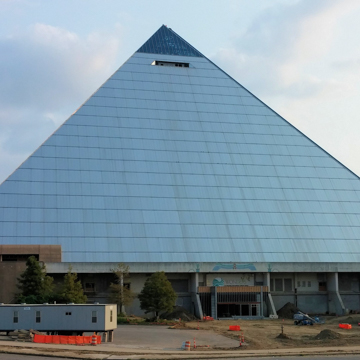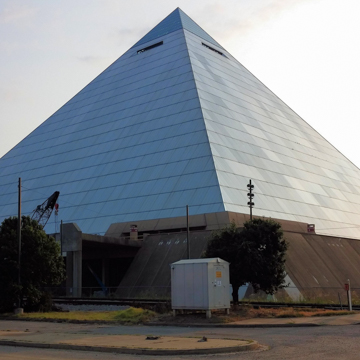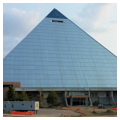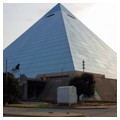You are here
Pyramid Arena
Located along the east bank of the Mississippi River is one of the largest buildings in Memphis, the Arena Pyramid. Rising to 321 feet, some thirty-two stories, the Pyramid covers an area equivalent to more than five football fields on a site of about thirty acres.
Most of the building is supported by four giant corner trusses, each 371 feet long and weighing 200 tons. Five cranes were needed to hoist each of them in place. Twenty-four smaller trusses fill the gaps between the corner trusses and serve as platforms for the grid of stainless steel panels. The result is an impressive central interior space that is open from floor to apex, uninterrupted by any vertical supports. This central space, once a 20,000-seat arena, is ringed with a two-story concrete arcade intended to house shops, restaurants, and museums.
The Pyramid was the dream of promoter Sidney Shlenker (1954–2003), owner of the Denver Nuggets, who wanted to provide Memphis with a “tourist magnet that would draw three million visitors a year.” Shlenker saw the promotional value of a pyramidal structure connecting Memphis, Tennessee, with its ancient namesake in Egypt. Built at cost of $65.5 million in public funds and $4.5 million in private funds, Shlenker predicted the building would repay its construction costs in twenty-five years. Groundbreaking in 1989 was the scene of fireworks, music, laser lights, and a helicopter-supported display of electric lights.
The opening event of the Pyramid Arena was the farewell concert for Wynonna and Naomi Judd. Some questionable engineering was revealed when the public toilets overflowed. Within months of the opening, Shlenker was fired for failing to raise $50 million in financing, and his management company filed for bankruptcy. Most of the facility was empty when it opened in November 1991. From the first, the Pyramid operated at a financial loss, and has been “mothballed” for much of its existence.
The Pyramid has hosted noteworthy concerts, including one by the Grateful Dead in 1995, four months before Jerry Garcia’s death. Basketball games and monster truck shows have also been featured over the years. More recently, the building has served as a training facility for Memphis fire and police departments.
In 2009, Shelby County released its fifty percent ownership of the building to the city of Memphis to facilitate negotiations with Bass Pro Shops Company. Now owned by Bass Pro Shops, the Pyramid received a $190 million makeover into a 220,000-square-foot Bass Pro Shops Outdoor World. Designed by O. T. Marshall Architects, the new facility, which includes a hotel, restaurants, shops, and a bowling alley, opened in April 2015.
References
Baird, Woody. “Big Pyramid, Little Wonder.” The Free Lance-Star(Fredericksburg, VA), November 9, 1991.
Griffis, Larry. “The Great American Pyramid.” Civil Engineering: The Magazine of the American Society of Civil Engineers60, no. 5 (May 1990): 56-58.
McMillin, Zack. “One Filled to the Rafters, Pyramid Sits Empty as its Future is Debated.” The Commercial Appeal(Memphis, TN), May 10, 2009.
Writing Credits
If SAH Archipedia has been useful to you, please consider supporting it.
SAH Archipedia tells the story of the United States through its buildings, landscapes, and cities. This freely available resource empowers the public with authoritative knowledge that deepens their understanding and appreciation of the built environment. But the Society of Architectural Historians, which created SAH Archipedia with University of Virginia Press, needs your support to maintain the high-caliber research, writing, photography, cartography, editing, design, and programming that make SAH Archipedia a trusted online resource available to all who value the history of place, heritage tourism, and learning.






